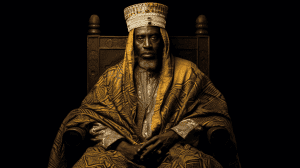The Nok Culture thrived in present-day Nigeria from around 1000 BC to 300 AD. Recognized for their remarkable terracotta sculptures, they represent West Africa’s earliest known art tradition. The Nok were also among the region’s first to smelt iron, marking significant technological advancement.
Origins of the Nok Culture
What an incredible journey it must have been for the Nok and Gajiganna peoples, travelling from the vast expanse of the Central Sahara to the northern region of Nigeria. They braved the harsh conditions and carried with them the essentials for survival, including precious pearl millet and the craft of pottery.

As they made their way through the unknown and unforgiving terrain, the two groups eventually parted ways. The Nok settled in the village that would become synonymous with their name, while the Gajiganna established their own home in the region bearing their name. The choices they made along the way would shape the course of their lives and the future of their people.
It’s also believed that the Nok culture were once part of the West African Sahel, their roots stretching far beyond the village they now called home. The desire for a better life, the yearning for a new beginning, propelled them forward to a place where they could plant their roots and flourish.
The Nok culture may have come into being as early as 1500 BCE and persisted until 1 BCE. The sheer longevity of their civilisation is a testament to their resilience and ingenuity, and it’s not hard to imagine the sense of pride and connection the Nok people must have felt to their land and their way of life.
Art and Technology from the Nok Culture
The Nok people were an extraordinary civilisation, and their terracotta sculptures were nothing short of remarkable. These sculptures weren’t just works of art but may have played a crucial role in a complex funerary culture that involved unique practices like feasting, symbolising the importance they placed on honouring their dead.
The earliest Nok terracotta sculptures date back to around 900 BCE and are a testament to the Nok people’s skill and ingenuity. Many of these sculptures depict figures using slingshots, bows, and arrows, indicating that the Nok people may have engaged in hunting and trapping wild animals to survive.
Their terracotta sculptures were mainly of human heads and figures as well as animals. One of the unique features of their sculptures are oval or triangular-shaped eyes on human faces. They also had elaborate hairstyles on human figures which suggests they appreciated personal adornment, particularly for the hair. Humans are normally shown with their hands on their knees or sat down.
But the Nok people’s skills weren’t limited to just sculpture. They also built dugout canoes to transport goods along the tributaries of the Niger River, expanding their trade routes to the Atlantic coast. The Nok people’s achievements rival those of the earlier Dufuna canoe, built some 8000 years ago in the northern region of Nigeria. The Nok terracotta sculpture of two people paddling a dugout canoe is particularly striking, a beautiful piece of art that shows the Nok people’s sophistication and attention to detail.

They used iron technology. Evidence suggests that their use of iron in that area dated back to approximately the 4th century BCE, maybe earlier. Archaeologists discovered 13 iron-smelting furnaces in the village of Taruga. They also found farming tools and weapons. They also used metal and stone tools. The Nok culture is one of the few in the world that went from stone tools (Stone Age) to iron tools (Iron Age) without learning how to make bronze or copper tools (Bronze Age) which is the typical process of the evolution of civilisations. Stone Age, then Bronze Age and then Iron Age.
Legacy of the Nok Culture
The legacy of the Nok people is shrouded in mystery, leaving many unanswered questions about their identity and origins. However, there are those who believe that the Nok’s incredible artistry had a significant impact on the metalworking techniques used by later societies like the Ife people. The Ife people, who lived in Nigeria between the 11th and 15th centuries C.E., were renowned for their lifelike metal sculptures of human heads that captured the essence of their subjects with stunning precision.
Despite this possibility, it’s still unclear whether the Nok people influenced later African civilisations. Their enigmatic culture leaves us with few clues about their society, social organisation, and way of life beyond what we can glean from their captivating terracotta artwork. The Nok people’s story is one of mystery and intrigue, leaving us to wonder about the secrets that lie buried in the sands of time.
Related Posts
Sources
Chesi, Gert and Gerhard Merzeder. The NOK Culture: Art in Nigeria 2500 Years Ago. Prestel, 2006.
National Geographic Society. “Nok Culture.” National Geographic Society, 2022, https://education.nationalgeographic.org/resource/nok-culture/.
History Today. “The Nok Culture.” Accessed February 15, 2023. https://www.historytoday.com/archive/nok-culture.





